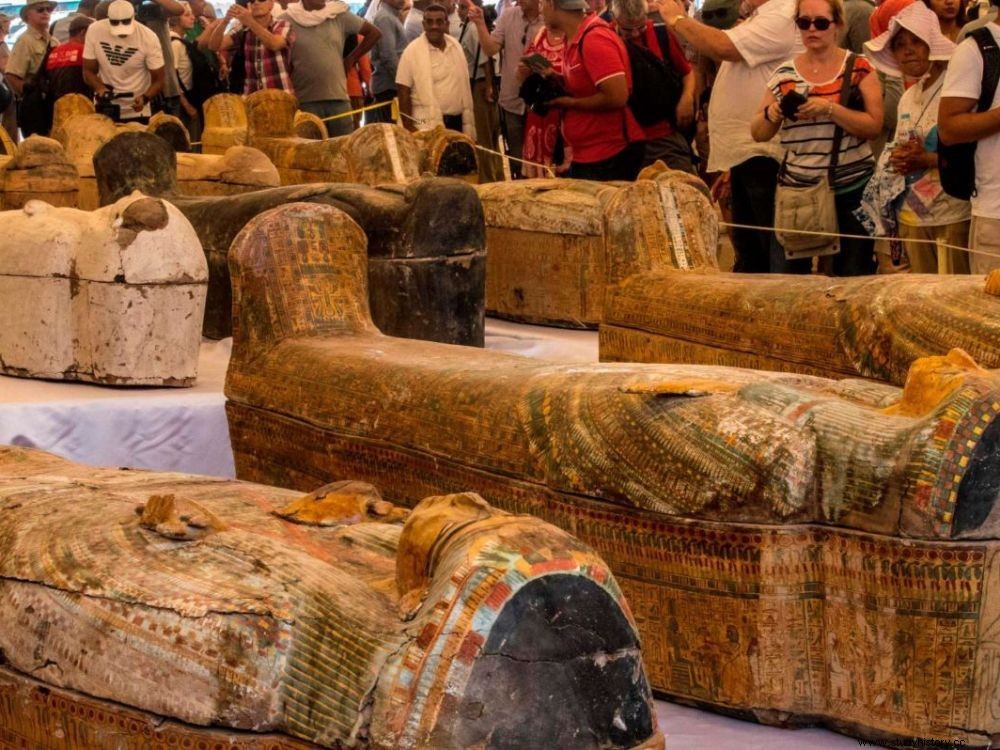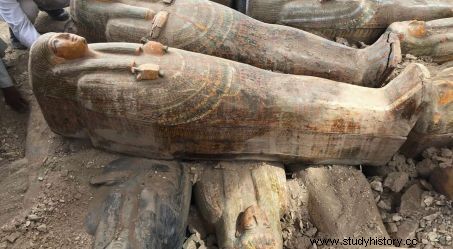The cache of an important set of about thirty colored and intact coffins have been unearthed on the banks of the Nile. They could relate to priests of Amun whose sarcophagi had been concealed during disturbances under the 22 e dynasty.

The sarcophagi of El-Asasif (Egypt) presented to the press on October 19, 2019.
Rich and delicate decorations of lotus flowers, birds, snakes... "The splendors buried in the secret of Egyptian soil seem inexhaustible" , declared at the beginning of the XX e century, the French Egyptologist Emile Amélineau (1850-1915). As soon as the doors of the Parisian exhibition Tutankhamun were closed, new treasures were revealed... A few days ago, Sciences et Avenir indeed announced the discovery of impressive painted sarcophagi, made in the sands of the desert in the land of the Pharaohs. Major finds, which the Egyptian authorities officially returned to on Saturday October 19, 2019, after initial "leaks"...
According to the Minister of Antiquities, Khaled Al-Anani, who addressed an audience of journalists on the esplanade of the temple of Hatshepsut, in Deir el-Bahari, in the presence of the president of the Supreme Council of Antiquities, Mustafa Waziri, thirty sarcophagi – 23 of men, 5 of women and 2 of children – have been identified in the necropolis of El-Asasif, on the western bank of the Nile. There, where ancient Thebes was located, the current Luxor, 600 km south of Cairo, the capital. The Egyptian official thus explained "that these sarcophagi had been recovered sealed, in the state in which the ancient Egyptians had left them" . True jewels of polychromy, they were "stacked" on top of each other on two levels:a first containing eighteen coffins, and the second, twelve.

The polychrome coffins of El-Asasif (Egypt), as they were found stacked in their cache. © Egyptian Ministry of Antiquities.
Insisting that it was "the first large cache of human sarcophagi unearthed since the end of the 19th th century" , the Minister recalled famous precedents. That of the two "caches" of royal mummies found in 1881, at Deir-el Bahari, for one, and in 1898, in the tomb of Amenophis II, for the other (see box ). A third, unearthed at Bab Al Gusses, around 1891, called "second hiding place of Deir el-Bahari ", contained a dozen mummies of priests belonging to the 21 th dynasty (1069 BC) and 22 th dynasty (945 BC)… Now it is to a family of these same priests who lived during the 22 th pharaonic dynasty, that could be attached the precious sarcophagi of El-Asasif!
"A new non-royal hideout"
"In the New Kingdom, at the end of the Ramesside period (1080 BC), the royal tombs began to be looted during a great period of economic and political collapse. kings, the high priests then wanted to protect their own graves by sheltering them in caches, in order to escape the cataclysm of looting" , specifies Pascal Vernus, Egyptologist, director of studies at the Ecole Pratique des Hautes Etudes (Paris), joined by Sciences et Avenir. "The main interest of the archaeological discovery of El-Asasif is that of being a new non-royal hiding place" , continues the famous Egyptologist.
Khaled Al-Anani has indeed clarified that they were high priests of Amun and Khonsu. "At the time, an important triad dominated, that of the god Amon, his wife Mut and their son Khonsu, god of the Moon", adds Pascal Vernus. A cult to the god Khonsu which had developed within the clergy of Thebes, in particular at the temple of Karnak, from the XXI th dynasty. In these sanctuaries, were also found priestesses, some of considerable status, which explains this female presence among the graves of El-Asasif. From the III th intermediate period, a tendency appeared among the priests of the region of Thebes for the organization of a hereditary transmission of the priestly function. The two burials of children detected, could also testify to this destination to the priesthood. In 2015, a Spanish team cleared the coffin of a priest named Anj-ef-Jonsu , officiating at the temple of Karnak. His sarcophagus was very similar to those resurrected at El-Asasif. The new, colorful coffins will be restored before being moved to an exhibition hall at the Grand Egyptian Museum (GEM), which is due to open next year, the antiquities minister concluded.
1881:The extraordinary royal hideout of Deir el-Bahari
Gaston Maspero, French Director of Egyptian Antiquities in Cairo, discover in 1881 more than 50 mummies of pharaohs gathered in a burial composed of 3 chambers. Carved into the Theban mountain of Deir el-Bahari, above the temples, this tomb was used to hide the mummies from the end of the Ramesside period, after 1069, to preserve them from the looting of the royal tombs which was rampant then. They remained there in secret for more than three thousand years.
1898:The royal hiding place of the tomb of Amenhotep II (or Amenhophis II).
Located in the Valley of the Kings, in the Theban Necropolis on the west bank of the Nile facing Luxor in Egypt, KV 35, the original tomb of Pharaoh Amenhotep II was used during the 21st Dynasty as a cache of royal mummies to preserve them from looting . When it was discovered in 1898, the mummies of many sovereigns were found there. The French Victor Loret had identified a dozen mummies of pharaohs there. Along with that of Deir el-Bahari, the two royal hiding places made it possible to rediscover most of the royal remains of the New Kingdom!
